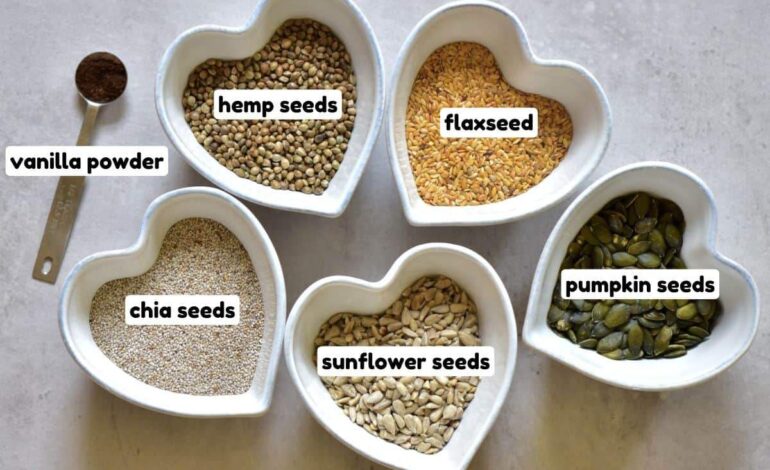Simple Homemade Protein Powder

Homemade protein powder: Protein powder has turned into a norm for some individuals attempting to become healthy and build muscle. It assists with weight loss and muscle building. Locally bought protein powders are convenient. However, they can be expensive and also contain counterfeit flavours and additional sugars. Creating protein powder at home is an extraordinary decision for anybody searching for an additional efficient and stimulating substitute. This blog will walk you through the upsides of making your protein powder and also give you a bit-by-bit instructional guide on the most proficient method to make it at home for both muscle building and weight loss.
This homemade protein powder uses a blend of 5 high-protein seeds for a cheaper (especially if they’re already in your pantry), cleaner way to boost your protein with no chemicals, fillers, or gums. Just clean, high-quality ingredients, easy to customize to your dietary and flavor preferences.
Combined, this DIY vegan protein powder recipe will help keep you feeling full for longer, aid with muscle growth and also tissue repair, provide a vitamin/mineral and omega boost, and also several other benefits. These may include reduced inflammation and blood pressure, regulating blood sugar levels, and improved skin, brain, and heart health.
Ingredients for Homemade Protein Powder
- Hemp Seeds: Make sure to use shelled hemp seeds/ hemp hearts (the ones photographed aren’t shelled). The shells are too hard to digest. These seeds contain an optimal ratio of omega-6 to omega-3, several minerals, 30g protein per 100 grams, and are a high-quality complete source of plant-based protein.
- Chia Seeds: These tiny seeds contain 18g of protein per 100 grams, gut-healthy fiber, omega-3 fatty acids, and also plenty of antioxidants.
- Flax Seeds: (aka linseed) You can use golden or brown linseed, which contain healthy omega-3s, lignans (a potent antioxidant), and about 18 g protein per 100 grams.
- Pumpkin seeds: (pepitas) These rich, green seeds contain 19g of protein per 100 grams and are a rich font of magnesium, iron, zinc, and plenty of antioxidants.
- Sunflower Seeds: Last but not least, this small but mighty seed is filled with nutrients, including a healthy dose of magnesium, potassium, zinc, iron, folate, and vitamins A, B, and E. They also contain 21-23g protein per 100g and ZERO cholesterol.
- Vanilla powder: (Optional) If you plan to serve the homemade protein powder in sweet formats only, a small amount of vanilla powder is a great way to boost flavor.
Why It’s Important to Grind each Seed Separately
For the best consistency: Just like when making nut and seed butter, different seeds have different hardness and oil levels. That means they’ll take a different amount of time to achieve the same powdery consistency. Grinding them individually allows you to ensure that you have the most consistent and even texture throughout.
To avoid over-processing: As certain seeds, like chia and flax seeds, become gummy if over-processed – which is likely when blending everything together.
For maximum nutrients: The longer you grind ingredients, the hotter the machine becomes, which can lead to nutrient degradation. Individual grinding ensures this is kept to a minimum. Likewise, some seeds, like flax seeds, are best if ground just before using them to preserve nutrients (their Omega-3 fatty acids) and keep them from becoming bitter too soon.
To customize the blend: For example, the ratio within the blend, thus overall flavor and texture. That way, you can more easily experiment with various combinations and proportions.
Incorporating Homemade Protein Powder into your Diet
Incorporating hand-crafted protein powder into your eating regimen is an adaptable way to deal with the assistance you need to develop muscle and also lose weight. Protein smoothies that are full and nourishing can be made by mixing them with water, milk, or a milk substitute and adding fruits or vegetables. For a delicious and nutritious meal, use it as the establishment for smoothie bowls and top with new fruits, nuts, and seeds. Assuming you need to up the protein content of your heated products, take a stab at adding protein powder to protein bars, pancakes, and biscuits. To support the protein worth of your yoghurt or porridge in the first part of the day, mix in a scoop.
Conclusion
To make your protein powder at home, accumulate your ingredients, turn on your blender, and get everything rolling! Making protein powder at home is a simple, reasonable, and refreshing substitute for locally acquired assortments. Make a protein powder that suits your dietary prerequisites and also tastes by utilising premium components and a simple-to-follow procedure. Visit the website of Genetic Nutrition today and explore top-notch quality nutrition supplements to meet your fitness goals.